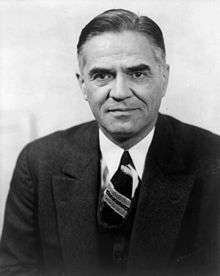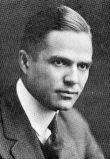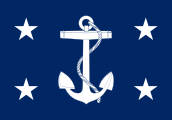Ralph Austin Bard
Ralph Austin Bard (July 29, 1884 – April 5, 1975) was a Chicago financier who served as Assistant Secretary of the Navy, 1941–1944, and as Under Secretary, 1944–1945. He is noted for a memorandum he wrote to Secretary of War Henry L. Stimson in 1945 urging that Japan be given a warning before the use of the atomic bomb on a strategic city. He was "the only person known to have formally dissented from the use of the atomic bomb without advance warning." [2]
Ralph Austin Bard | |
|---|---|
 Ralph Austin Bard | |
| Under Secretary of the Navy | |
| In office 24 June 1944 – 30 June 1945 | |
| President | Franklin D. Roosevelt Harry S. Truman |
| Preceded by | James Forrestal |
| Succeeded by | Artemus Gates |
| Assistant Secretary of the Navy | |
| In office 24 February 1941 – 24 June 1944 | |
| President | Franklin D. Roosevelt |
| Preceded by | Lewis Compton |
| Succeeded by | H. Struve Hensel |
| Personal details | |
| Born | July 29, 1884 Cleveland, Ohio |
| Died | April 5, 1975 (aged 91) Deerfield, Illinois |
| Political party | Republican |
| Spouse(s) | Mary Hancock Spear |
| Alma mater | Princeton University |
| Occupation | financier |
| Awards | Navy Distinguished Service Medal [1] Navy Distinguished Civilian Service Award |
| Signature |  |
Early life and business career

Born in Cleveland, Ohio, Bard was the second of three children born to George Morris Bard (1852-1932) and Helen Norwood Bard (1858-1947).[3] He went to Princeton University, where he lettered in baseball, basketball and football.[4] After graduating in 1906, he embarked on a career as an investment banker in Chicago, eventually becoming head of his own firm.[5] He married Mary Hancock Spear (1886-1949) in 1909. They had four children. Bard was active in civic organizations in the Chicago area, including Boy Scouts of America and the American Red Cross. He was also a trustee of Northwestern University.[6]
Service at the Navy Department
Although he was an active Republican,[7] Bard was appointed Assistant Secretary of the Navy by President Franklin D. Roosevelt, a Democrat who had once held the same post.[8] As Assistant Secretary, Bard was responsible for all matters relating to civilian personnel and the general administration of the Navy Department. Divisions under his control included Shore Establishments, Transportation, Supervision and Management, the Administrative Office, and the Management Engineer's Office. He instituted a sweeping industrial relations program, covering such areas as training, classification, safety, labor relations, recruiting, and efficient use of manpower, and established a Personnel Relations Division in every major naval activity. As a result of his efforts, there was no strike or work stoppage at any Navy activity during World War II. Bard was also a member of the War Manpower Commission, established by President Roosevelt to balance the wartime labor needs of the civilian and military sectors of the U.S. economy. Upon becoming Under Secretary on June 24, 1944, Bard added responsibility for all Navy uniformed personnel to his other duties.[9] Bard also served as acting Secretary of the Navy from April 28, 1944 to May 19, 1944, following the death of Secretary Frank Knox.
Bard and integration of the Navy
We prate about our unity of purpose. Then we retire to the
woodshed with a sharp pencil and a clean shingle, to figure
out whether the agricultural or the petroleum interests will grab
the synthetic rubber business, and whether the British-Dutch
rubber cartel will be revived after the war to threaten this new
industry. We hope that we can enlist the support of the masses
of Latin America and our own Negroes, without having to do
too much toward solving the agrarian problems of our neighbors
to the south or the economic problems of our fellow-Americans.
And we hope that the Russians will whip the Nazis, but not be
too unreasonable about spreading their uncomfortable doctrines
outside of Russia.
And all the time we have a dusty standard in the attic around
which we could all rally if we would but break it out and
understand its dynamic implications.
tolerance, humility, sacrifice and understanding of the meaning
of human dignity.
−Ralph Austin Bard, Speech to the Industrial Union of Marine and
Shipbuilding Workers of America, New York City, September 24, 1942 [10]

When Bard became Assistant Secretary, Navy policy was to prohibit African Americans from enlisting for "general duty" (combat) roles, restricting them to service as "messmen." Although Bard's duties as Assistant Secretary did not extend to uniformed personnel, his office often dealt with racial discrimination and its consequences. As a member of a committee appointed to investigate the Navy's racial policies, Bard's special assistant Addison Walker argued for allowing enlistment of a small number of African Americans for general duty on an experimental basis; and Bard himself promised Mark Abridge, who chaired President Roosevelt's Fair Employment Practices Committee, that enlistment of African Americans would be given consideration. Under pressure from President Roosevelt, the Navy announced in 1942 a new policy of accepting African American volunteers (but not draftees) for general duty positions in segregated units, a practice that continued until 1948 when President Truman issued Executive Order 9981 racially integrating the United States Armed Services. In 1944, the Navy began the training of African Americans as commissioned officers.[11]
Bard's memorandum to Stimson
In 1945, Bard became one of eight members of the Interim Committee appointed to advise President Harry S. Truman on the use of the atomic bomb.[12] Although Bard joined in the committee's unanimous recommendation that the bomb should be used in combat as soon as possible and without warning,[13] he developed second thoughts. In a memorandum dated June 27, 1945, to Secretary of War Henry L. Stimson,[14] Bard argued that Japan should receive two or three days' "preliminary warning" before the bomb was used. "The position of the United States as a great humanitarian nation and the fair play attitude of our people generally is responsible in the main for this feeling," Bard wrote, adding that he felt "that the Japanese government may be searching for some opportunity which they could use as a medium of surrender." The memorandum also suggested that Japan be informed of "Russia's position," i.e., the likely entry of the Soviet Union into the war, and that "assurances" be given "with regard to the Emperor of Japan and the treatment of the Japanese nation following unconditional surrender."[15] However, the extensive incendiary raids on Japanese cities under General Curtis LeMay that killed at least 350,000 civilians desensitized U.S. authorities,[16] and the Japanese government did not respond to the Potsdam Declaration in late July 1945 outlining the conditions for unconditional surrender.
On August 6, 1945, the first atomic bomb was dropped on the Japanese city of Hiroshima without the warning that Bard recommended, inflicting approximately 70,000 deaths, including 20,000 Japanese combatants and 20,000 Korean slave laborers. On August 8, the Soviet Union declared war on Japan and launched the invasion of Manchuria which decimated the already-weakening Manchukuo Imperial Army. On August 9, a second bomb was used on the Japanese city of Nagasaki, killing approximately 35,000 people, including 27,778 Japanese munitions employees, 2,000 Korean slave laborers, and 150 Japanese combatants. On August 15, the Emperor announced the surrender of Japan.[17]
| Wikisource has original text related to this article: |
| Wikisource has original text related to this article: |
Bard submitted his resignation as Under Secretary at about the time the Interim Committee made its recommendation to Truman on the use of the bomb. He left his post a month later. There is no evidence that he resigned in disagreement with the recommendation or because his own recommendations to Stimson were not followed.[18]
Later life
In 1946, Bard received the Navy's Distinguished Service Medal.[19] In his later years, he made his residence in Lake Forest, Illinois.[20] He was honorary chair of the committee that brought the captured German submarine U-505 to the Museum of Science and Industry in Chicago. He received the Navy's Distinguished Civilian Service Award in 1954,[21] and he died in a nursing home in Deerfield, Illinois on April 5, 1975, at age 91.[22] He is buried in the Lake Forest Cemetery.
Bard papers
Bard's papers (1941–1944) are housed at the Naval Historical Center in Washington, DC.[23]
![]()
Notes
- "Hall of Valor: Ralph A. Bard". militarytimes.com. Sightline Media Group. Retrieved 26 December 2017.
- Gar Alperovitz, The Decision to Use the Atomic Bomb and the Architecture of an American Myth (New York: Alfred A. Knopf, 1995), p. 225. ISBN 0-679-44331-2
- United States of America, Bureau of the Census. Twelfth Census of the United States, 1900; Census Place: Chicago Ward 32, Cook, Illinois; Roll: 287; Page: 16A; Enumeration District: 1032. Lists children Francis N. (age 18); Ralph A. (age 15); and Roy E. (age 12). Source: Ancestry.com. 1900 United States Federal Census [database on-line]. Provo, UT, USA: Ancestry.com Operations Inc, 2004.
- Time Magazine, "Chicago Buyers," September 16, 1929
- Barton J. Bernstein, "The Debate on Industrial Reconversion: The Protection of Oligopoly and Military Control of the Economy," American Journal of Economics and Sociology, Vol. 26, No. 2 (April, 1967), pp. 159-172 Companies in which Bard became an investor included the Auburn Automobile Company (1919). See Indiana Historical Society, "Historical Sketch" in "Indiana Automobile Advertisements, 1916–1996, Collection Guide" and the Wahl Company (1939), which made Eversharp pens. (See "The $64 Answer", Time Magazine, October 21, 1946.)
- Who Was Who in America, v. 6 (1974-1976), Chicago: Marquis Who's Who, 1978, p. 20, col. 3. ISBN 0-8379-0207-X
- "Ralph Bard dies;fought A-bombing," Chicago Tribune, April 7, 1975, p. E10.
- Roosevelt was Assistant Secretary, 1913-1920, under President Woodrow Wilson. Roosevelt considered appointing his political adviser Thomas ("The Cork") Corcoran to the job, but decided on Bard based on the recommendation of Navy Secretary Frank Knox. See "Back-Seat Driver," Time Magazine, February 24, 1941. Knox wanted to appoint Bard to the post of Under Secretary in 1940 after William J. ("Wild Bill") Donovan declined it, but Bard also declined. By the time he changed his mind, the job had gone to James V. Forrestal. Townsend Hoopes and Douglas Brinkley, Driven Patriot: The Life and Times of James Forrestal, Naval Institute Press, 2000, p. 129. ISBN 1-55750-334-6
- Biographical Note, Papers of Assistant Secretary of the Navy Ralph A. Bard, USN, Operational Archives Branch, Naval Historical Center, Washington, D.C.
- http://www.ibiblio.org/pha/policy/1942/1942-09-24a.html Vital Speeches of the Day, Vol. VII, pp. 21-23
- Morris J. MacGregor, Jr., Integration of the Armed Forces, 1940-1965, U.S. Army Military History Center, 1985, Chapter 3. and Lisha B. Penn, Records of Military Agencies Relating to African Americans from the Post-World War I Period to the Korean War, National Archives and Records Administration, Reference Information Paper 105, 2006, pp. 101-102.
- Notes of the Interim Committee Meeting, May 31, 1945, pp. 1-3.
- Notes of the Interim Committee Meeting, June 1, 1945, pp. 8-9.
- The memorandum was sent to Stimson through George L. Harrison, who acted as the Interim Committee's secretary. A facsimile copy of Bard's memorandum and of Harrison's covering memorandum to Stimson is found at The George Washington University.
- id.
- Dennis D. Wainstock (2011). The Decision to Drop the Atomic Bomb: Hiroshima and Nagasaki: August 1945. Enigma Books. p. 128.
- Nuke-Rebuke: Writers & Artists Against Nuclear Energy & Weapons (The Contemporary anthology series). The Spirit That Moves Us Press. May 1, 1984. pp. 22–29.
- Robert James Maddox, Weapons for Victory: The Hiroshima Decision, Columbia:University of Missouri Press, 2004, p. 70. ISBN 0-8262-1562-9
- "Ralph A. Bard, 90, Navy Leader, dies". The New York Times. April 7, 1975. Retrieved December 12, 2017.
- Who Was Who in America, supra.
- James E. Wise, U-505: The Final Journey, Naval Institute Press, 2005, pp. 110-11. ISBN 1-59114-967-3
- Chicago Tribune, April 7, 1975, supra.
- Papers of Assistant Secretary of the Navy Ralph A. Bard, USN, Operational Archives Branch, Naval Historical Center, Washington, D.C.
Further reading
- Alice Kimball Smith, "Behind the decision to use the atomic bomb: Chicago 1944-1945", Bulletin of the Atomic Scientists, September 1958, pp. 288–312
- U.S. News and World Report, "Was A-Bomb on Japan a mistake?", August 15, 1960; pp. 62–76, 115-116.
External links
| Wikimedia Commons has media related to Ralph Austin Bard. |
- "Launching of USS Wisconsin (BB-64). Philadelphia Navy Yard, December 7, 1943". April 25, 2014. Retrieved December 12, 2017.
Film footage of Assistant Secretary of the Navy Ralph A. Bard speaking at launch of battleship USS Wisconsin.
- "Ralph Austin Bard". Find a Grave. Retrieved 2017-12-12.
| Government offices | ||
|---|---|---|
| Preceded by Lewis Compton |
Assistant Secretary of the Navy 24 February 1941–24 June 1944 |
Succeeded by H. Struve Hensel |
| Preceded by James V. Forrestal |
Under Secretary of the Navy 24 June 1944–30 June 1945 |
Succeeded by Artemus Gates |


